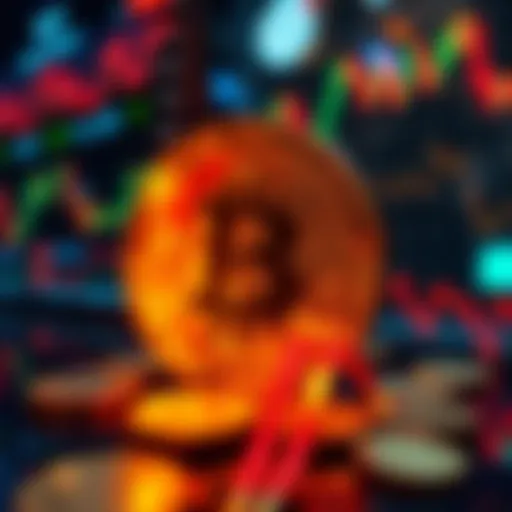Navigating the Purchase of DeFi Assets: A Comprehensive Guide


Intro
In the world of finance, things move pretty fast, but nowhere is this truer than in decentralized finance, or DeFi. This emerging field turns traditional banking on its head, offering a chance for individuals to take control of their own finances without middlemen. But stepping into this arena can feel like navigating a maze without a map—especially while purchasing DeFi assets. Understanding what DeFi is and how to safely engage with it is crucial for any investor or enthusiast looking to make a mark.
This guide seeks to unravel the complexities surrounding DeFi asset acquisition, helping you dodge common pitfalls while also giving you the keys to the kingdom so to speak. Whether you're a seasoned investor or just dipping your toes into the waters of cryptocurrency, there are invaluable insights and best practices that will enhance your experience. So, let’s roll up our sleeves and dive deep into the essential concepts underpinning this innovative financial landscape.
Crypto Concepts Explained
In order to get a firm grip on purchasing DeFi assets, it's necessary to start with the fundamentals. Knowing the lingo will help—and we want every investor to be on solid ground before they make a big move.
Key Terminology and Definitions
To help decipher the landscape of DeFi, familiarize yourself with some key terms:
- Smart Contracts: These are self-executing contracts with the terms directly written into code. Imagine them as digital vending machines; you put in your tokens, and the machine does its magic.
- Liquidity Pools: Think of this as a shared pot of money. Users can deposit their tokens for others to borrow from, and in return, they earn fees. A great way for investors to put their assets to work.
- Decentralized Exchanges (DEXs): Instead of a bank facilitating your trades, DEXs connect buyers and sellers directly. This means you’re trading directly with peers rather than through an intermediary.
- Yield Farming: A strategy to maximize returns by strategically allocating assets across different DeFi platforms to earn interest or new tokens. Picture this like spreading your seeds across various gardens to ensure a bountiful harvest.
Understanding such terms not only empowers you in conversations but also helps in making decisions that resonate with your investment strategy.
Practical Applications of Blockchain Technology
Blockchains offer a robust foundation for DeFi. They serve as transparent ledgers that record transactions. Let's break it down further:
- Transparency and Security: All transactions are publicly recorded and verifiable, creating a level of trust rarely seen in traditional finance.
- Ownership: Through decentralized systems, users retain ownership of their assets without needing a third party to manage them.
- Access: Individuals around the globe can access and use financial services without barriers, opening doors that were previously shut.
By acknowledging the practicalities of blockchain, investors can understand better how it enables the DeFi ecosystem and opens avenues for investment.
Investment Strategies
Once you are grounded in the crypto concepts, the next step is formulating a strategy for acquiring these assets. Markets can be unpredictable, and it helps to know how to read the signals.
Analyzing Market Trends and Indicators
Keeping a keen eye on market trends is essential. Consider these indicators:
- Price Movement Patterns: Analyze the historical price movements of assets to spot potential entry or exit points.
- Volume: Check trading volumes. High volume often indicates strong investor interest, which might suggest upcoming price movements.
Tools like TradingView can be instrumental in providing charts and analysis tools to observe these metrics.
Risk Management Techniques
No investment is without its risks, especially in the DeFi space. Employing risk management strategies can save you from disastrous losses:
- Diversification: Spread your investments across various assets. Don’t put all your eggs in one basket. This way, if one asset flops, you have others to fall back on.
- Setting Limits: Use stop-loss and take-profit orders. Setting these can automate your losses and gains, allowing you to let emotions take a back seat during volatile periods.
- Continuous Learning: Keep ding your homework. Changes in the DeFi landscape can happen overnight. Stay informed through channels like reddit.com or relevant Twitter accounts.
Understanding Decentralized Finance
Decentralized Finance, often known as DeFi, represents a radical shift in the financial landscape. Understanding its core principles is essential for investors, analysts, and developers. This section aims to dissect the pivotal role DeFi plays in the broader financial ecosystem.
DeFi is fundamentally about removing intermediaries, providing individuals with direct control over their financial assets. This translates to lower costs and quicker transactions, which can be a breath of fresh air compared to traditional banking systems plagued by delays and high fees. By grasping the importance of DeFi, one can appreciate its potential impact, not just on personal finance, but on global economic structures.
In a world going digital, the relevance of DeFi cannot be overstated. Many see it as a means to democratize finance, making it accessible to those who have been historically excluded from traditional banking systems. This inclusivity is not merely an added bonus; it’s a core consideration for anyone looking to invest or build within this space.
Moreover, understanding DeFi equips individuals with the tools to evaluate risks versus rewards more adeptly. While the opportunities can look enticing, awareness of pitfalls like market volatility and smart contract vulnerabilities is crucial.
There are elements that make learning about DeFi particularly beneficial:
- Transparency in Transactions: Every transaction is recorded on the blockchain, providing a level of trust and accountability.
- Innovation in Financial Products: New financial instruments, borrowing, lending, and trading options emerge regularly, often offering greater flexibility than traditional equivalents.
- Global Accessibility: Anyone with internet access can participate, breaking down geographical barriers.
Investors, analysts, and developers who immerse themselves in these concepts can gain a competitive edge in navigating this innovative financial ecosystem.
Assessing the DeFi Landscape
The decentralized finance (DeFi) landscape is a crucial aspect of the digital asset sphere that warrants careful evaluation. In a rapidly changing market, understanding the intricacies of DeFi platforms and services can significantly impact an investor's decision-making process. Consider this: diving headfirst into DeFi without a clear grasp of its current atmosphere can lead to missed opportunities or, worse, substantial losses. Hence, this section provides insights into the pulse of DeFi, enabling investors, developers, and enthusiasts to navigate with confidence.
Current Trends in DeFi
DeFi is buzzing like a beehive, with innovations that propel its growth and adoption. Currently, trends like yield farming and staking have found their niche among investors. Yield farming allows anyone with some crypto to earn extra returns by providing liquidity to various platforms. Staking involves locking up tokens to support network operations in exchange for rewards. Both concepts infuse additional layers of engagement and potential profit but require understanding the underlying mechanisms.
Another trend gaining traction is cross-chain functionality. This functionality enables assets to move seamlessly across different blockchain networks. It mitigates the so-called liquidity fragmentation issue, making it easier for users to interact with diverse platforms. When you couple this with the rise of layer 2 scaling solutions, the DeFi ecosystem is set for even broader horizons.


Amid these trends, investor awareness around security has heightened. Smart contracts, while revolutionary, come with risks inherent to their design. Continuous audits and transparency in the code become paramount. As new projects spring up like wildflowers, assessing the legitimacy and security of these platforms has never been more critical.
Major DeFi Platforms
Uniswap
Uniswap stands tall as a key player in the DeFi arena. Renowned for its automated market-making protocol, it allows users to swap ERC-20 tokens without the need for a centralized exchange. What makes Uniswap particularly attractive is its user-friendly interface and low transaction fees, compared to traditional exchanges. The main draw, however, lies in its unique liquidity pools, where users can provide liquidity in exchange for a share of transaction fees.
Nonetheless, it’s worth noting that Uniswap isn't without its challenges. Slippage can be a hiccup due to on-going market volatility, and the impermanent loss that liquidity providers might face is a consideration that cannot be dismissed lightly.
Aave
Aave is another significant name within the DeFi ecosystem. This platform excels in lending and borrowing, giving users the ability to earn interest on their deposits, much like a traditional bank. The standout characteristic of Aave is its flash loan feature, which allows users to borrow assets without collateral, as long as the liquidity is returned within a single transaction.
While this unique feature signifies innovation, it also raises eyebrows regarding potential misuse, leading to questions about security and trustworthiness. Users must weigh the benefits of high flexibility against the risks involved in such arrangements.
Compound
Compound has carved out a niche in the DeFi world as a leading lending protocol. Here, users can earn interest by depositing their crypto assets or take out loans against their holdings. One of Compound’s notable advantages is its algorithmic interest rates, which automatically adjust based on supply and demand. This dynamic nature provides a compelling reason for users to engage actively on the platform.
However, the complexity of understanding how these interest rates fluctuate can be a stumbling block for less experienced users. Thus, while Compound offers a strong platform, it demands a deeper understanding from its participants, which could be a deterrent for some.
Market Opportunities and Challenges
The DeFi landscape is filled with opportunities as well as hurdles. On the one hand, gaining access to decentralized lending, borrowing, and trading opens up financial services to a broader audience without the lag and limitations often imposed by banks. The potential for higher returns and innovation are undoubtedly enticing. Investors have the chance to leverage their assets in ways that were scarcely imaginable a few years back.
However, it's crucial to approach this market with a wary eye. Regulatory scrutiny is intensifying, and compliance issues can lead to rapid changes in platform operations or even market access. Additionally, the volatility of the crypto market can lead to rapid losses, making it imperative for investors to have a sound risk management plan in place. As the adage goes,
Preparation for Purchasing DeFi Assets
Decentralized finance, or DeFi, brings a unique set of opportunities and challenges. Preparing to purchase DeFi assets is not merely a good idea; it’s essential for anyone looking to dive into this financial landscape. Without a solid foundation, one could find themselves stumbling through the process, potentially making costly mistakes.
In this section, understanding how to navigate the initial steps will set the stage for successful investment. It lays the groundwork by covering essential elements such as the types of wallets available, the cryptocurrency exchanges one might consider, and the verification procedures that need to be in place. Each of these components contributes towards ensuring safer and more informed transactions in the DeFi sphere, minimizing the risks associated with making purchases.
Understanding Wallet Options
An indispensable part of the DeFi ecosystem revolves around how you store your assets. Wallets are of two primary types: hot wallets and cold wallets. Both serve their purpose, but each has distinct characteristics and applications.
Hot Wallets
Hot wallets are designed for convenience and accessibility, ideal for those who engage with the market frequently. They are always connected to the internet, making it easy to execute trades or access funds on a moment's notice.
- Key characteristic: Accessibility. When you want to make a quick trade, hot wallets allow smooth and rapid transactions.
- Unique feature: Most hot wallets come with user-friendly interfaces appealing to both novices and experienced users alike. However, this ease of use translates to a drawback. Their constant connection to the internet makes them more susceptible to hacking and other cyber threats.
In an environment where timing can be everything, hot wallets provide an almost instant solution for transactions, but a balance is necessary between convenience and security.
Cold Wallets
On the flip side, cold wallets offer a different approach by storing cryptocurrency offline. This makes them a secure option for investors who aren't necessarily looking to make frequent transactions.
- Key characteristic: Security. These wallets are not connected to the internet, which protects users against online threats.
- Unique feature: They come in hardware or paper formats, offering an effective way to safeguard assets from cyber attacks. Yet, managing cold wallets requires more diligence. Forgetting or losing access to the physical storage medium could have dire consequences, leading to irreversible loss of the stored assets.
In summary, weighing the pros and cons of hot and cold wallets is crucial. Each serves a different purpose and understanding when to use which can greatly influence the safety and success of your DeFi journey.
Selecting a Cryptocurrency Exchange
After establishing how you plan to store your assets, attention must shift to selecting a cryptocurrency exchange. This choice significantly influences the ease and safety of purchasing DeFi assets.
Centralized Exchanges
Centralized exchanges are perhaps the most well-known platforms for trading cryptocurrencies. They act as intermediaries between buyers and sellers, providing a straightforward interface for users.
- Key characteristic: User-Friendly Experience. These platforms often feature intuitive designs catering to both beginners and seasoned investors.
- Unique feature: Many centralized exchanges offer additional services such as customer support, security measures, and advanced trading tools. However, as intermediaries, users must place trust in the exchange, making it crucial to choose reputable ones. Hacking incidents and fraud are not uncommon among some platforms, which should always keep investors on their toes.
The reliability of centralized exchanges can drive ease of use, but also poses risks associated with storing assets on a platform versus in personal wallets.
Decentralized Exchanges
Decentralized exchanges (DEXs) present a different paradigm, allowing peer-to-peer trading without an intermediary. They tap into the principles of DeFi by enabling users to trade directly from their wallets.
- Key characteristic: Autonomy. This setup grants full control over assets, minimizing third-party interference.
- Unique feature: The lack of a central authority means users are responsible for managing their assets safely. It can be harder to find intuitive interfaces; however, many users appreciate the increased privacy and lower fees that DEXs often provide. On the flip side, the responsibility to safeguard assets falls squarely on the user, which can be daunting for newcomers.


Choosing between centralized and decentralized exchanges often comes down to personal preference, risk tolerance, and the desired level of control over one’s funds. Each option presents distinct benefits and matters that should be carefully considered before making a decision.
Registration and Verification Process
Once you have determined the type of exchange to use, the next step involves understanding the registration and verification process. This might feel tedious, but it’s where essential anti-fraud measures come into play.
Most exchanges require you to create an account, which usually involves providing personal information and verifying your identity. This process is critical for several reasons. Primarily, it helps prevent illicit activities like money laundering and fraud. In many countries, regulation mandates specific verification steps to ensure system integrity.
Notably, some exchanges might have more strict requirements, demanding proof of residence or more comprehensive personal documentation than others. Understanding what is required beforehand can streamline your entry into the DeFi space, reducing potential transaction hiccups.
To wrap things up, preparation for purchasing DeFi assets spans multiple dimensions. Armed with knowledge about wallets, exchanges, and verification, investors are better positioned to navigate their DeFi investment journey with confidence.
Purchasing DeFi Assets
Purchasing DeFi assets represents a pivotal step for individuals looking to immerse themselves in the decentralized finance landscape. This process is crucial because it transforms mere interest into actionable investment, allowing participants to leverage the advantages of blockchain technology. With DeFi's rapidly changing ecosystem, making informed purchases can mean the difference between successful asset accumulation and monetary loss. Thus, understanding how to effectively navigate these waters is essential for anyone entering this arena.
Funding Your Wallet
Choosing Payment Methods
When it comes to influencing how easily one can get into the DeFi space, selecting the right payment method stands out as a key factor. It determines the speed and efficiency with which funds can be moved into your wallet. A common choice among many in the crypto community is bank transfers, often favored for their reliability and established processes. However, methods like credit or debit cards are also becoming popular due to their convenience and immediate liquidity.
The standout feature of choosing a payment method is the level of familiarity and trust it provides the user. A traditional bank transfer, for example, may take longer but usually comes with lower fees compared to using credit cards or third-party services that could charge hefty transaction costs. On the flip side, while cryptocurrencies themselves might be the end goal, using fiat methods for purchases is often seen as a necessary stepping stone into this dynamic space.
Transferring Funds
Transferring funds into your chosen wallet is another crucial aspect of the purchasing process and sets the stage for engaging with DeFi assets. This step requires meticulous attention to detail, ensuring the right addresses are used to avoid irreversible mistakes. A defining characteristic here is the necessity for accuracy, as a simple misstep can lead to lost assets.
Using services that offer direct transfers into your wallet, like P2P exchanges, can be beneficial due to their enhanced user-friendliness. However, challenges such as transaction loading times or occasional network congestion can sometimes complicate matters. Always consider the trade-offs, as this process can greatly affect the efficiency of your overall investment strategy.
Executing a Trade
Placing Buy Orders
The act of placing buy orders is where strategy meets action, forming the foundation for building a DeFi asset portfolio. This process allows buyers to acquire specific tokens at their preferred price points, thus engaging directly with market dynamics. A notable characteristic of placing buy orders is the control it affords to the investor, allowing them to specify the number of tokens and the price willing to pay, optimizing for potential profits.
However, one must acknowledge that market conditions can shift rapidly. This means buyers might miss ideal opportunities if they don’t act fast enough or don’t set their parameters appropriately. Being aware of fluctuating market conditions can be the key to executing timely trades that yield favorable outcomes.
Setting Limit Orders
In contrast, setting limit orders offers a strategic layer of engagement in trading, permitting users to specify the maximum price they are willing to pay for a certain asset. This method can be particularly attractive when market prices are volatile and investors seek to limit potential losses. The key benefit here is the automatic handling of the trade when the market conditions meet the set parameters, thus minimizing the need for constant monitoring.
A unique feature of limit orders is the risk of missing out on potential acquisitions if the market swings away from the set price. Notably, while this can protect from unfavorable prices, there exists the trade-off of potentially passing up desirable tokens that might rise in value dramatically.
Understanding Token Standards
ERC-20 Tokens
Diving into the world of decentralized finance means becoming familiar with various token standards, including ERC-20 tokens. This standard is highly regarded for its vast usage within the Ethereum network, representing a significant portion of the market. One of the primary advantages of ERC-20 tokens is their compatibility with a wide range of wallets and decentralized applications, making them an easy choice for newcomers in the DeFi space.
Despite this, potential downsides do exist with ERC-20 tokens, such as susceptibility to smart contract bugs or mismatched crypto wallets, which can jeopardize transactions and holdings if not handled cautiously. It’s crucial for buyers to understand these nuances, which enables secure investment and management of these tokens.
BEP-20 Tokens
On the other hand, BEP-20 tokens, which operate on the Binance Smart Chain, merit attention for their increasing relevance in the DeFi ecosystem. With lower transaction costs and quicker processing times compared to their Ethereum counterparts, they are often seen as a favorable alternative. The unique characteristic of BEP-20 tokens lies in their design which seeks to enhance compatibility across various platforms without the heavy gas fees.
Still, the rapid growth of the Binance Smart Chain comes with its own set of concerns, mainly due to this relatively young ecosystem's level of maturity and inherent risks regarding security measures. Understanding these facets is essential for mitigating possible issues that could arise during trading.
Post-Purchase Considerations
Once the excitement of buying DeFi assets wears off, there become crucial steps to safeguard and grow those investments. This section sheds light on the importance of employing solid practices after purchase. Many traders may find it easy to dive into the shiny world of assets. However, understanding what comes next is just as vital. This encompasses everything from smart storage solutions to effectively monitoring performance and navigating the complex arena of tax implications. These elements not only protect investments but also contribute to a sound financial strategy in DeFi.
Secure Storage Practices
Backup Strategies
Backups are like having a safety net for your digital assets. They ensure that you can recover your funds if anything goes awry—be it a lost device or a breached system. A good backup strategy often entails keeping a copy of recovery phrases and essential wallet files in multiple secure locations. This redundancy is key; should one method fail, your assets won't vanish into thin air. A popular backup method among users is the use of encrypted cloud storage or hardware wallets, which can securely save essential files offline.
Backing up your data isn't just about safety; it's also a wise approach to mitigate risks involved with technology, because we all know, systems can be fickle.
Managing Private Keys


Private keys function as the password to your wallet, granting access to your digital fortress. It's crucial to manage them with the utmost care. The key characteristic of these keys is their absolute control: if you have the private key, you have access to the assets. Conversely, if it's lost or mishandled, there's no recovery avenue. Some prefer to keep their private keys offline to avoid hacking threats.
However, this can be a double-edged sword. While securing private keys offline offers protection, it also introduces challenges in convenience and accessibility. The trick is to find a balance, understanding that a well-managed private key is just as important as the assets it unlocks.
Monitoring DeFi Investments
Tracking Performance
Keeping tabs on your investments can make or break your experience in the DeFi landscape. Tracking performance helps investors make data-driven decisions. Various platforms and apps allow users to monitor price movements and liquidity, enabling timely adjustments based on market trends. Many tools also provide insights into historical performance, facilitating performance comparisons. Staying informed helps in navigating the often turbulent waters of DeFi.
One must remember: in finance, timing is everything—having a few tricks up your sleeve can transform a potential loss into a significant gain.
Setting Alerts
Setting up alerts functions as an advanced strategy to maintain engagement without the need to constantly check prices. By configuring notifications for significant price changes or market developments, investors can better manage their DeFi portfolio.
This practice is especially beneficial in the volatile world of DeFi, where prices can swing like a pendulum in a matter of minutes. Efficient alert systems help to keep emotions at bay and help in making calculated decisions based on real-time data rather than reacting impulsively.
Tax Implications of DeFi Investments
Understanding the tax landscape surrounding DeFi assets is essential yet often overlooked. As regulations evolve, so do the obligations of investors. Cryptocurrency transactions can lead to taxable events, and being unprepared can have significant financial implications.
It’s prudent for investors to note down each transaction meticulously, keeping records that can simplify tax filings. Adopting professional guidance on tax matters can also serve as a safety net that shields investors from unforeseen future liabilities. Navigating these intricacies requires diligence but can lead to more informed and efficient financial planning.
Risks Involved in DeFi Purchasing
In the realm of decentralized finance, being in the know about the different risks becomes essential for anyone looking to make a purchase. Understanding these risks is crucial not only for protecting investments but also for fostering a sustainable relationship with this emerging financial ecosystem. Let's take a closer look at some of the main concerns that investors need to consider when diving into DeFi assets.
Smart Contract Vulnerabilities
Smart contracts serve as the backbone of DeFi, executing trades, ensuring transactions, and managing user interactions without the need for intermediaries. However, they are also susceptible to various vulnerabilities. A poorly coded smart contract might lead to significant losses if exploited. The infamous "DAO hack" in 2016 is a case in point, where vulnerabilities led to over $60 million in Ether being siphoned off due to a flaw in a smart contract.
To mitigate risks, it's advisable to stick with well-audited projects and platforms that have transparent records. Always check whether the smart contracts have undergone third-party audits, as these can help root out potential issues before they become costly. Remember, when engaging with DeFi, it’s like building a house on a shaky foundation: if the smart contract isn't robust, the entire structure could collapse.
Market Volatility
The DeFi market is known for its dizzying highs and gut-wrenching lows. Prices can fluctuate wildly in a matter of minutes, spurred by various factors such as market sentiment, regulatory news, or even changes in technology. Investors might experience rapid gains or losses, and this volatility can induce a sense of panic or euphoria that clouds judgment, leading to impulsive decisions.
For instance, one day you might see a token skyrocket in value, only for it to plummet the next day. This rollercoaster is not for the faint of heart. Investors should educate themselves on technical analysis and market trends and be ready for potential downturns. Setting stop-loss orders could offer some protection against sudden price crashes. Staying level-headed is critical in an unpredictable market like DeFi, where fortunes can turn on a dime.
Regulatory Risks
As DeFi continues to gain traction, governments and regulatory agencies are increasingly taking notice. Regulatory risks involve uncertainty regarding laws governing digital assets, which can lead to sudden changes that affect the market. For instance, a country may outlaw specific DeFi activities or impose heavy taxes on transactions, causing upheaval in the market.
It's advisable to keep tabs on regulatory developments in your jurisdiction and worldwide. Reading resources such as the Securities and Exchange Commission (SEC) guidelines could offer insights on regulatory landscapes. Staying informed can empower investors to make prudent decisions amid shifting sands surrounding DeFi regulations. Ignoring these aspects might leave you walking a tightrope without a safety net.
Understanding and proactively addressing these risks will help investors navigate the complexities of DeFi purchasing. Knowledge and preparation can serve as your best allies in this rapidly evolving space.
By giving thought to these risks, investors can better position themselves to enjoy the benefits of DeFi while minimizing potential setbacks.
Future of DeFi Purchases
The future of decentralized finance (DeFi) purchases is a topic brimming with potential and implications that can reshape our financial landscape. As the DeFi ecosystem continues to evolve, understanding the trajectory of this innovation is paramount for investors, analysts, and developers keen on capitalizing on emerging opportunities. Several critical elements underpin the significance of this subject, including technological advancements, shifts in market dynamics, and strategic guidance for stakeholders navigating this complex terrain.
Emerging Technologies in DeFi
Merely skimming the surface of DeFi applications won't cut it anymore. New technologies are consistently pushing boundaries. One standout is layer-2 scaling solutions, which enhance transaction speed and significantly reduce fees on networks like Ethereum. Another fascinating development is interoperability protocols, such as Polkadot and Cosmos. These allow different blockchains to communicate seamlessly, creating an expansive ecosystem for DeFi applications.
Furthermore, innovations like Decentralized Identity (DID) systems will likely play a crucial role, particularly in ensuring user privacy while maintaining security. The promise of artificial intelligence in automating trading strategies and improving risk assessments also deserves attention. As these technologies proliferate, expect to see easier access to DeFi assets, improved efficiency in transactions, and a more user-friendly interface for both seasoned investors and newcomers.
Predicted Market Changes
The DeFi market seems poised for a roller coaster of changes in the coming years. Based on expert analyses, an influx of traditional financial institutions entering the DeFi arena could shift power dynamics. We're likely to witness a converge of CeFi (Centralized Finance) and DeFi with hybrid models emerging. This blending could offer the best of both worlds, combining the security of centralized services with the open-access ethos of DeFi.
Another anticipated shift is the increasing focus on regulatory compliance. As governments and regulatory bodies start taking a more active role in overseeing crypto markets, businesses operating in the DeFi space will need to adapt. This may lead to a more structured environment, ultimately fostering investor confidence.
The success of DeFi in the long run will depend greatly on balancing innovation with regulatory considerations.
Finally, expect to see a growing diversity in DeFi products. From synthetic assets to DeFi insurance, the variety will expand, providing users with more tools than ever before to manage risk and reward.
Advice for Investors
Investors keen on navigating the future of DeFi purchases should heed several pieces of advice. Firstly, / stay informed. The landscape changes at a dizzying pace, and keeping up with developments through resources like CoinDesk, Decrypt, and community discussions on platforms like Reddit is essential.
Moreover, diversification is key. Rather than placing all bets on one DeFi project, spread investments across different assets and protocols to hedge against market volatility.
For more insights into the role of DeFi in future finance, explore resources such as Investopedia and Financial Times.















